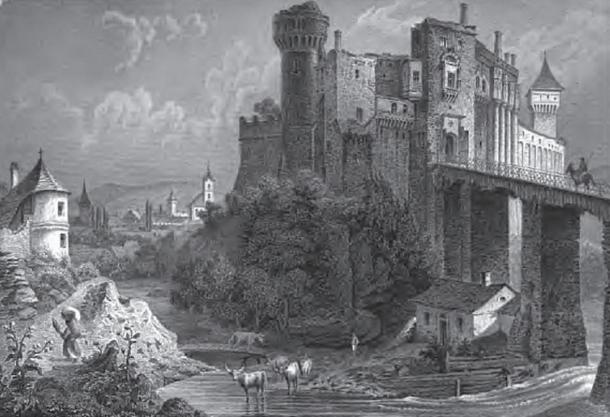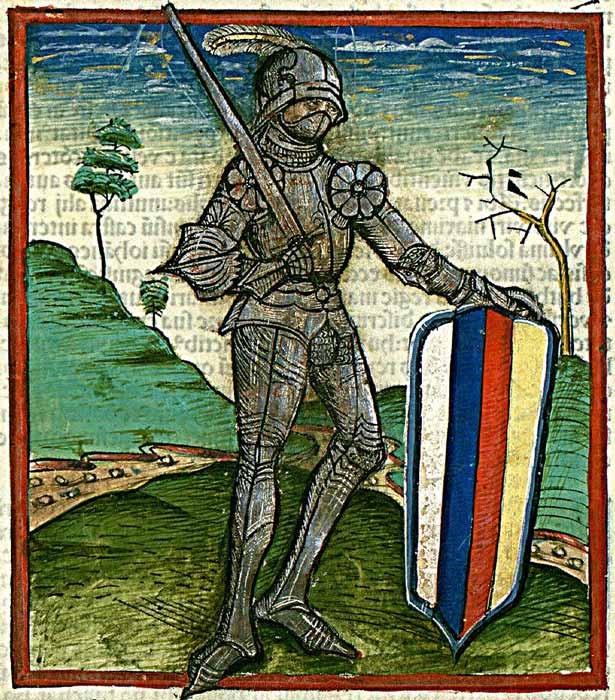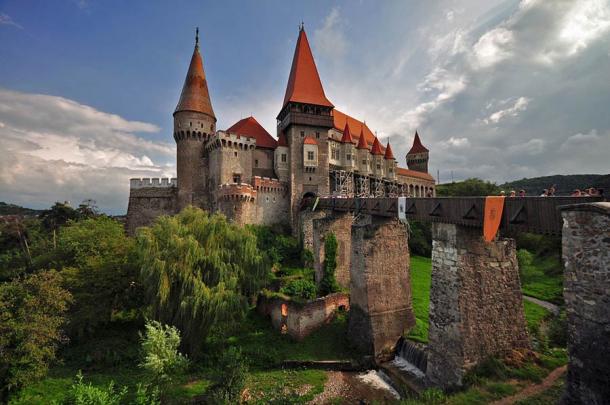Corvin Castle is a castle in Hnedoara, a city in Transylvania, Romania. The castle dates to the 15th century and was built in the Renaissance-Gothic style. The builder of Corvin Castle was John Hunyadi, best remembered for his defense of Christendom against the Ottomans. After Hunyadi’s death, Corvin Castle fell into ruin. It was only during the 17th century that the castle was restored. Corvin Castle is one of the largest castles in Europe and is today commonly considered as one of the “Seven Wonders of Romania.”
Corvin Castle is known also as Hunyadi Castle, or the Hunedoara Castle. Although the castle was built during the 15th century, the site was already occupied by earlier fortifications before that. It is claimed that there was a Roman camp on the site of the castle. Subsequently, the Angevin rulers of Hungary, which Transylvania was part of during the Middle Ages, built a keep on the site. It was, however, only around the middle of the 15th century that Corvin Castle was built.

The ruins of Corvin Castle in 1865. ( Public domain )
Corvin Castle Was Built the Legendary Warrior John Hunyadi
Corvin Castle is named after its builder, John Hunyadi, whose name in Medieval Latin, incidentally, was Ioannes Corvinus. Hunyadi’s Latin epithet, Corvinus, was in fact first used by the biographer of his son and successor, Matthias Corvinus. Nevertheless, it is sometimes applied to Hunyadi as well. This epithet is derived from the word “corvus,” meaning raven. The significance of the raven to this noble family is reflected in the fact that its coat of arms depicts this bird with a gold ring in its beak. This has to do with a rather interesting legend.
According to the legend, Hunyadi was the illegitimate son of Sigismund, the king of Luxembourg and Hungary, and Erzsébet Morzsinay, who hailed from a Hungarian noble family. To avoid dishonoring Erzsébet, the king decided to marry her to one of his knights, a Wallachian boyar by the name of Vojk. In addition, Sigismund gave Erzsébet a gold ring as a gift to the unborn child, so that when he presents himself at the royal court, the king would be able to recognize him.
One day, when Hunyadi was still a child, his family took him on a trip. As they halted for lunch, a raven, attracted by the shine of the gold ring, stole it from Hunyadi. When the boy saw what had happened, he immediately took a bow and arrow, and shot the raven down, thereby retrieving the ring. Sigismund was impressed when he heard this story and decided to bestow the image of the raven with a ring in its beak as the coat of arms of Hunyadi’s family.
It is thought that this legend was discreetly spread by Hunyadi himself, as a means of strengthening the claims of his descendants to the throne of Hungary. After all, for all that Hunyadi had achieved, he was not of royal descent, and therefore could not claim the throne.
In any event, Hunyadi accomplished much during his lifetime, and was regarded as a hero of Christendom. As a youth, Hunyadi entered the service of Sigismund, and was involved in several military campaigns. For instance, Hunyadi participated in the Hussite Wars , which broke out in 1420, during which he studied Hussite tactics, and later adopted their method of using wagons for war.

John Hunyadi depicted in the 15th-century Chronica Hungarorum. (János Thuróczy / Public domain )
The Man Behind Corvin Castle Defeated the Ottomans Twice!
Hunyadi, however, is best remembered for his campaign against the Ottomans during the 1440s and 1450s. In 1441, for instance, Hunyadi defeated the Ottomans at Semendria, Serbia, and again in the following year at Nagyszeben. The latter victory brought Wallachia back under the suzerainty of Hungary. Hunyadi’s last victory against the Ottomans was in 1456, during which he succeeded in forcing the Ottomans to lift the siege of Belgrade. This victory resulted in a 70-year period of relative peace on Hungary’s southeastern border and slowed down the Ottoman advance into Europe. A few weeks after the siege was lifted, however, a plague broke out in Hunyadi’s camp, and Hunyadi himself fell victim to it.
Although Corvin Castle was built by Hunyadi, it had been in the hands of his family since 1409, when it was given to his father by Sigismund. When Hunyadi inherited the property, he designed the castle as both a defensive fortress and a prison . The castle towers held both war prisoners and ordinary ones. It is said that there is a bear pit inside the castle, into which the unfortunate prisoners were thrown.
According to one legend, the infamous Vlad the Impaler was once held a prisoner in Corvin Castle. The seven-year imprisonment in the castle is blamed for his madness. However, another version of the story says Vlad was imprisoned by Matthias Corvinus in Vesegard, Hungary.
And another legend claims that the castle well was cursed by three Ottoman prisoners . These prisoners were promised freedom once they completed their task of digging the well. Once the work was done, however, the prisoners were condemned to death. Therefore, they cursed the well before their execution.
Corvin Castle is divided into three main areas: the Knight’s Hall, the Diet Hall, and the circular staircase . Both halls are rectangular in their layout and decorated with marble. Their function, however, differed. The Knight’s Hall was used for feasting, whilst the Diet Hall served as the place for ceremonies and formal receptions.
Work on the castle was still going on at the time of Hunyadi’s untimely death. Consequently, the construction work was halted. Nevertheless, it was resumed by Matthias Corvinus, who added a Renaissance-style wing, which included paintings depicting the life of nobles.

Today, Corvin Castle today is in pretty good shape, but further restoration projects are in the works. (Paszczur01 / CC BY-SA 3.0 )
The Castle Fell Into Decline But Continues to be Renovated
Subsequently, however, Corvin Castle fell into decline. It was only during the 17th century that there was renewed interest in the castle. During this time, the castle was redesigned according to what the workers thought a Gothic-style castle ought to look like. As a consequence, the castle acquired the look it has today. Three major restorations were also carried out during the 19th and 20th centuries, the first in the 1870s, the second between 1965 and 1970, and the third between 1993 and 1995.
Today, Corvin Castle is a tourist site opened to the public. According to an article from 2017, one of the major threats currently faced by the castle is the deteriorating effects of weathering and time. It was also reported that more restoration will be carried out on the castle. Indeed, it is widely hoped that Corvin Castle may be preserved for future generations .
Top image: Corvin Castle, also known as Hunyadi Castle or Hunedoara Castle, is a Gothic-Renaissance castle in Hunedoara, Romania. Photo source: Adrianstanica.ro / CC BY-SA 4.0
By Wu Mingren
Related posts:
Views: 0
 RSS Feed
RSS Feed

















 October 22nd, 2021
October 22nd, 2021  Awake Goy
Awake Goy  Posted in
Posted in  Tags:
Tags: 
















